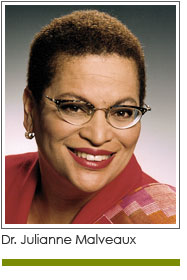 As Black History Month draws to a close, it is interesting to ponder the many ways we have (and have not) commemorated the month that evolved from Dr. Carter G. Woodson's 1926 inception of Negro History Week. In the nearly 75 years since the Harvard-educated historian asserted the importance of African American History, African American people have moved from the outhouse to the White House, and many would argue that we are better off than we have ever been. Others would point to the disparities in income, employment, education, and opportunity to suggest that much more must be done before we have attained social and economic justice.
As Black History Month draws to a close, it is interesting to ponder the many ways we have (and have not) commemorated the month that evolved from Dr. Carter G. Woodson's 1926 inception of Negro History Week. In the nearly 75 years since the Harvard-educated historian asserted the importance of African American History, African American people have moved from the outhouse to the White House, and many would argue that we are better off than we have ever been. Others would point to the disparities in income, employment, education, and opportunity to suggest that much more must be done before we have attained social and economic justice.
One of the glaring inequities in our space is the difference between the ways whites and African Americans are represented in our nation's statuary. Every city sports statues of war heroes and politicians, with an activist thrown in here or there. Most of the statues are of white men, with a few white women thrown in for good measure. Every now and then there will be a bust or statue of Dr. Martin Luther King, Jr. Black women are mostly invisible in the public statuary.
There are statues of Sojourner Truth in Battle Creek, Michigan and Florence, Massachusetts. Last April, thanks to the work of the late C. Delores Tucker and the National Congress of Black Women, a bust of Sojourner Truth was installed in the US Capitol. She is the first African American woman to be so honored, and it took a decade and the focused work of the women of the Congressional Black Caucus to make it happen. These committed Congresswomen have started a Sojourner Truth Movement to empower women in leadership, employment, and federal service.
There are also statues of Mary McLeod Bethune in Washington, DC at Lincoln Park and at Bethune Cookman University, which she founded. And, there is a wonderful statue of Harriet Tubman in Harlem. This list is not exhaustive - Oakland is to install a tribute to Ruby Bridges and Dr. Maya Angelou this spring. Still, black women are woefully underrepresented, virtually invisible, in the public statuary.
This is why I was excited when Dr. Patricia Reid-Merritt asked me to join the Fannie Lou Hamer Statue Committee that will erect a statue to the civil rights leader in Ruleville, Mississippi. Fannie Lou Hamer is a heroine, an icon, a role model, and an inspiration, a woman who deserves to be lifted up, commemorated, and memorialized. She was born in 1917 and died of breast cancer when she was just shy of 60, in 1977. As the eulogizers often say, it is not the beginning or end, but the dash that really matters. Mrs. Hamer managed to cram a lot of living and giving into her dash.
She joined the Student Non-Violent Coordinating Committee (SNCC) in 1962 and was the first African American in Sunflower County, Mississippi to register to vote. She was so badly beaten on June 9, 1963, that she carried the effects of the beating (including kidney damage and an injured eye) for the rest of her life. Still, she stated that her goal was "to register every Negro in Mississippi). She challenged the Democratic Party on the representation of African Americans in its delegation during the 1964 Democratic National Convention, and challenged both Lyndon Johnson and Hubert Humphrey on the righteousness of her position. She was a delegate to the 1968 Democratic National Convention.
Fannie Lou Hamer dropped out of school in the sixth grade, but her pithy wisdom has informed generations. She was "sick and tired of being sick and tired", and exhorted black folks, "with Ph.Ds or no Ds" to remember "we are in this bag together. She reminded Christians "we serve God by serving our fellow man," and railed against hunger and poverty. She spoke to the way freedom movements are intertwined, asserting that "nobody's free until everybody's free", and was one of the founders of the National Women's Political Caucus in 1971.
Can the sister get a statue? She can if enough people support the cause. There is information about the statue effort at www.fannielouhamer.info. Check the site out and, if you are so moved, embrace the project. As Black History Month winds down, consider the fact that our public spaces only scantly reflect an African American presence in our nation, either historically or contemporaneously. In the words of Fannie Lou Hamer, we are sic k and tired of being invisible. Helping to erect a Hamer statue will commemorate the legacy of a powerful woman and enhance the public visibility of African American women and our contributions.

today in black history
December 22, 2025
Dr. Chancellor Williams, historian and author of "The Destruction of Black Civilization" is born in 1898 in Bennetsville, South Carolina.
Honoring Fannie Lou Hamer
Sick and Tired of Being Invisible
POSTED: February 24, 2010, 12:00 am
Dr. Julianne Malveaux is a noted economist and president of Bennett College for Women.










